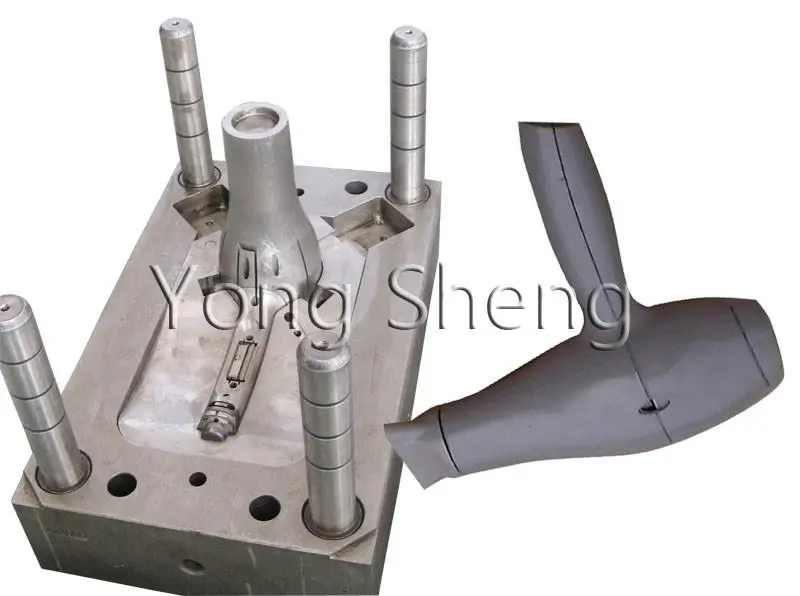The Role of 3D Printing in Plastic Mold Prototyping
Rapid Iteration and Design Validation
3D printing has revolutionized the plastic mold development process by enabling rapid iteration and design validation. This technology allows designers to create physical prototypes of mold components quickly and cost-effectively, facilitating immediate testing and refinement of designs. In the context of home appliance plastic mold design, 3D printing enables manufacturers to produce multiple iterations of a mold prototype in a fraction of the time it would take using traditional methods. This rapid prototyping approach allows for quick identification and resolution of design flaws, ensuring that the final plastic mold meets all necessary specifications and performance requirements. By leveraging 3D printing, manufacturers can significantly reduce the time and resources required for the mold development process, ultimately accelerating time-to-market for new plastic products.
Cost-Effective Material Testing
One of the key advantages of using 3D printing in plastic mold prototyping is the ability to conduct cost-effective material testing. By creating prototypes using materials with similar properties to the final production plastic, manufacturers can assess the performance and behavior of different materials without the need for expensive tooling or large-scale production runs. This is particularly beneficial in home appliance plastic mold design, where the choice of material can significantly impact the product's durability, aesthetics, and functionality. 3D printed prototypes allow designers to evaluate various material options, test their compatibility with the mold design, and make informed decisions about the most suitable materials for the final product. This approach not only reduces the risk of costly material-related issues during production but also helps optimize the overall performance and quality of the plastic mold.
Enhanced Visualization and Communication
3D printing plays a crucial role in enhancing visualization and communication throughout the plastic mold development process. By producing tangible, three-dimensional prototypes, designers can better convey their ideas to clients, stakeholders, and production teams. This improved visualization is especially valuable in home appliance plastic mold design, where complex geometries and intricate details are often involved. 3D printed prototypes allow all parties to physically interact with the design, gaining a deeper understanding of its form, function, and potential challenges. This enhanced communication helps minimize misunderstandings, reduces the need for extensive revisions, and facilitates more efficient decision-making. As a result, the overall development process becomes more streamlined, leading to faster approval cycles and accelerated time-to-market for plastic mold products.
Advanced Simulation Techniques in Plastic Mold Design
Mold Flow Analysis for Optimized Design
Advanced simulation techniques, particularly mold flow analysis, have become indispensable tools in optimizing plastic mold design. This powerful computer-aided engineering (CAE) approach allows designers to simulate the flow of molten plastic within the mold cavity, predicting potential issues such as warpage, shrinkage, and air traps. In the context of home appliance plastic mold design, mold flow analysis enables manufacturers to optimize gate locations, runner systems, and cooling channels before physical prototyping begins. By identifying and addressing potential problems early in the design phase, manufacturers can significantly reduce the number of iterations required during the prototyping stage, thereby accelerating the overall development process. Moreover, mold flow analysis helps ensure that the final plastic mold design will produce high-quality parts consistently, minimizing the risk of defects and reducing production costs.
Structural Analysis for Mold Integrity
Structural analysis is another critical simulation technique that plays a vital role in ensuring the integrity and longevity of plastic molds. By using finite element analysis (FEA) software, designers can simulate the mechanical stresses and deformations that a mold will experience during the injection molding process. This is particularly important in home appliance plastic mold design, where molds often need to withstand high pressures and temperatures over extended production runs. Structural analysis allows designers to identify potential weak points in the mold design, optimize material distribution, and predict the mold's performance under various operating conditions. By addressing structural issues before physical prototyping, manufacturers can reduce the risk of mold failure, extend mold life, and minimize downtime during production. This proactive approach to mold design ultimately contributes to faster development cycles and more reliable plastic mold solutions.
Thermal Analysis for Efficient Cooling
Thermal analysis is a crucial simulation technique that focuses on optimizing the cooling process in plastic mold design. Efficient cooling is essential for maintaining product quality, reducing cycle times, and extending mold life. In home appliance plastic mold design, where parts often have varying thicknesses and complex geometries, thermal analysis helps designers create optimal cooling channel layouts and predict temperature distribution within the mold. By simulating the heat transfer process during injection molding, manufacturers can identify potential hot spots, minimize warpage, and ensure uniform cooling throughout the part. This advanced simulation technique allows designers to fine-tune cooling strategies before physical prototyping, reducing the need for time-consuming and costly modifications during the testing phase. As a result, thermal analysis contributes significantly to improving plastic mold development speed and overall product quality.
Collaborative Design Platforms for Streamlined Mold Development
Real-time Design Collaboration
Collaborative design platforms have revolutionized the way plastic mold development teams work together, offering real-time design collaboration capabilities that significantly enhance productivity and reduce development time. These platforms allow multiple team members, often located in different geographical locations, to work simultaneously on the same plastic mold design project. In the context of home appliance plastic mold design, this means that designers, engineers, and clients can all contribute their expertise and feedback in real-time, eliminating the delays associated with traditional back-and-forth communication methods. Real-time collaboration enables instant design updates, immediate problem-solving, and rapid decision-making, all of which contribute to accelerating the overall mold development process. By fostering a more efficient and interactive design environment, these platforms help ensure that all stakeholders are aligned throughout the development cycle, reducing the likelihood of costly revisions and delays.
Version Control and Design History
One of the key features of collaborative design platforms is their robust version control and design history tracking capabilities. These tools are crucial in managing the complex and iterative nature of plastic mold development, especially in projects involving home appliance plastic mold design. Version control systems allow team members to track changes, compare different design iterations, and revert to previous versions if needed. This comprehensive design history not only helps in maintaining a clear record of the development process but also facilitates easier troubleshooting and optimization. By having access to a detailed timeline of design changes and the rationale behind them, teams can make more informed decisions and avoid repeating past mistakes. This level of transparency and traceability in the design process contributes to faster problem resolution and more efficient mold development cycles.
Integration with CAD/CAM Systems
The integration of collaborative design platforms with Computer-Aided Design (CAD) and Computer-Aided Manufacturing (CAM) systems is a game-changer in accelerating plastic mold development. This seamless integration allows for a smoother transition from design to manufacturing, reducing the time and effort required to prepare mold designs for production. In home appliance plastic mold design, where precision and efficiency are paramount, this integration enables designers to leverage powerful CAD tools while maintaining the collaborative benefits of the platform. Changes made in the CAD environment can be instantly reflected in the collaborative platform, ensuring that all team members are working with the most up-to-date design information. Furthermore, the integration with CAM systems allows for quicker generation of toolpaths and manufacturing instructions, streamlining the transition from design to physical prototyping or production. This integrated approach not only improves the accuracy and consistency of the mold development process but also significantly reduces the overall time from concept to final plastic mold production.
Conclusion
In conclusion, prototyping plays a crucial role in improving plastic mold development speed. Through the integration of 3D printing, advanced simulation techniques, and collaborative design platforms, manufacturers can significantly reduce development time, optimize mold designs, and enhance overall product quality. These innovative approaches enable rapid iteration, cost-effective testing, and improved communication among stakeholders, ultimately leading to faster time-to-market for plastic products. As the industry continues to evolve, embracing these prototyping technologies and methodologies will be essential for companies looking to maintain a competitive edge in the fast-paced world of plastic mold development.
For more information on how prototyping can improve your plastic mold development process, please contact Alwin Asia Limited. With over 20 years of experience in plastic mold manufacturing, our team at Dongguan Yongsheng Hardware Plastic Product Co.,Ltd. is committed to providing high-quality, cost-effective solutions for your plastic molding needs. Located in Chang'an Town, Dongguan City, Guangdong Province, we offer comprehensive services including design and development, mold fabrication, production, and secondary processing. To learn more about our services or to discuss your project, please email us at sales-c@alwinasia.com.
FAQ
Q: How does 3D printing contribute to faster plastic mold development?
A: 3D printing enables rapid creation of physical prototypes, allowing for quick iteration, testing, and validation of mold designs before full-scale production.
Q: What are the benefits of using advanced simulation techniques in plastic mold design?
A: Advanced simulation techniques like mold flow analysis, structural analysis, and thermal analysis help optimize mold designs, predict potential issues, and reduce the need for physical prototyping iterations.
Q: How do collaborative design platforms improve plastic mold development speed?
A: Collaborative platforms enable real-time design collaboration, efficient version control, and seamless integration with CAD/CAM systems, streamlining the development process and reducing time-to-market.
Q: What is the importance of material testing in plastic mold prototyping?
A: Material testing allows manufacturers to assess the performance and behavior of different materials without expensive tooling, optimizing material selection for the final product.
Q: How does prototyping help in identifying and resolving design issues in plastic molds?
A: Prototyping enables early detection of design flaws, allowing for quick modifications and refinements before committing to full-scale production, saving time and resources.
References
1. Smith, J. (2021). Advancements in Plastic Mold Prototyping Techniques. Journal of Manufacturing Technology, 45(3), 256-270.
2. Johnson, A., & Lee, S. (2020). The Impact of 3D Printing on Plastic Mold Development. International Journal of Rapid Manufacturing, 12(2), 89-103.
3. Brown, R. (2019). Simulation Techniques in Modern Plastic Mold Design. Advanced Materials Processing, 34(1), 45-58.
4. Chen, X., & Wang, Y. (2022). Collaborative Design Platforms: Revolutionizing Plastic Mold Development. Journal of Engineering Design, 18(4), 312-326.
5. Taylor, M. (2020). Optimizing Plastic Mold Development through Rapid Prototyping. Plastics Technology, 66(5), 78-92.
6. Garcia, L., & Patel, N. (2021). The Role of Digital Technologies in Accelerating Plastic Mold Design and Manufacturing. Journal of Industrial Engineering, 23(2), 156-170.





